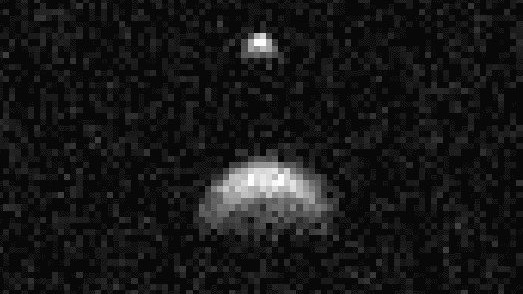Asteroid 2018 EB has a moon
Eddie Irizarry in SPACE | October 17, 2018
Binary asteroids – that is, asteroids with moons – aren’t uncommon. More than 300 have been discovered so far. Astronomers found a moon for 2018 EB when it swept closest to Earth on October 7.
Asteroid 2018 EB and its moon.
Asteroid 2018 EB has an orbit around the sun that’s very similar to Earth’s orbit, but with a different inclination. As a result, every year for countless millions or even billions of years, this space rock has been coming relatively close to our planet twice, in April and October. In April, 2018, astronomers spotted it, at last, using NASA’s NEOWISE spacecraft. Then, at the October passage, they found something else. Asteroid 2018 EB has a moon!
Asteroid 2018 EB is not huge in contrast to the biggest asteroids. But it’s good-sized, with an estimated diameter of 509 feet (155 meters) to 787 feet (240 meters).
Scientists at Arecibo Observatory in Puerto Rico and at the Goldstone Radar in California made the recent radar observations showing the secondary or satellite asteroid – the moon – orbiting this asteroid, as both space rocks swept within 15 lunar-distances of Earth on October 7, 2018. This was close enough for astronomers using radar to get a better-than-usual look.
That’s when they spotted the moon.
The space rock made an approach of 10 lunar distances in April 4, 2018, while on October 7, 2018, it passed at 15 times the Earth-Moon distance.
The asteroid’s approaches of this year are the closest until 2147, as the space rock comes by then at less than 4 times the Earth-moon distance, according to NASA/JPL.
Asteroids with companions or moons aren’t uncommon. Astronomers have identified more than 300 space rocks with moons. Some have two moons; that is, some asteroids are triple.
Asteroid 2018 EB is classified as a potentially hazardous object, meaning it comes close to Earth during parts of its orbit, and it’s large enough to cause regional damage if it were to strike us.
But no strikes by this asteroid, or its moon, are anticipated anytime soon. The trajectory of the space rock has been calculated for at least the next 171 years, and calculations show all passes will be at safe distances.
 |
 |
|
|||||||||||
 |
 |
||||||||||||
|
|
|
|
|
|
|
||||||||
 |
|
|
|
|
|
 |
|||||||
|
|
|
|
|||||||||||
|
|
|||||||||||||
|
|
|
|
|
|
|
|
|
|
|
|
|
|
|
Results 1 to 1 of 1
Thread: Asteroid 2018 EB has a Moon
-
10-17-2018, 12:52 PM #1
Asteroid 2018 EB has a Moon
Beginner's Guide for Rocket, NFPS and IKS66...
http://iptvtalk.net/showthread.php?2...-you-should-do
Kodi Options for Rocket, NFPS and IKS66...
http://iptvtalk.net/forumdisplay.php?71-Kodi
Check the Announcement Section...
http://iptvtalk.net/forumdisplay.php...-Announcements
Similar Threads
-
Asteroid flyby ... 2020 LD passed within the moon’s distance
By ilan in forum The Universe Closer to HomeReplies: 0Last Post: 06-11-2020, 12:16 PM -
Asteroid flyby ... 2018 UA
By ilan in forum The Universe Closer to HomeReplies: 0Last Post: 10-21-2018, 12:15 PM -
Speck from an asteroid
By ilan in forum The Universe Closer to HomeReplies: 1Last Post: 08-07-2018, 07:22 PM -
Asteroid Day
By ilan in forum The Universe Closer to HomeReplies: 0Last Post: 06-30-2018, 05:54 PM -
Asteroid flyby ... asteroid originally designated ZLAF9B2 – now called 2018 LA
By ilan in forum The Universe Closer to HomeReplies: 0Last Post: 06-04-2018, 12:06 PM








 Reply With Quote
Reply With Quote